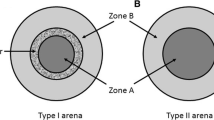Summary
The burrowing behaviour of the toad Bufo viridis was studied in the laboratory on soil containing 11–13% moisture. These toads usually excavate shallow, temporary burrows from which they emerge intermittently. Time spent subsurface increases with rising ambient temperature in the range of 18–30° C. In these conditions, water loss is effectively reduced and a new water balance is achieved. On return to water access, after two months on soil, the toads rapidly regain only that amount of water lost previously. It is concluded that this temperature-sensitive burrowing behaviour is an important factor in these animals' successful survival in semi-arid conditions.
Similar content being viewed by others
References
Cochran DM (1961) Living Amphibians of the world. Doubleday and Co., NY
Degani G, Silanikove N, Shkolnik A (1984) Adaptation of green toad (Bufo viridis) to terrestrial life by urea accumulation. Comp Biochem Physiol 77A:585–587
Emerson SB (1976) Burrowing in frogs. J Morphol 149:437–458
Hillyard SD, Brekke D, Winckur RM (1987) Behavior associated with substrate moisture absorption by the toad. Am Zool 27:12A
Hoffman J, Eilath U, Katz U (1988) Bufo viridis: physiological responses to osmotic stress (burrowing and salt adaptation). Israel J Zool 35:103–104
Katz U, Gabbay S (1986) Water retention and plasma and urine composition in toads (Bufo viridis Laur.) under burrowing conditions. J Comp Physiol B 156:735–740
Katz U, Pagi D, Hayat S, Degani G (1988) Plasma osmolality, urine composition and tissue water content of the toad Bufo viridis Laur. in Nature and under controlled laboratory conditions. Comp Biochem Physiol 85A:703–713
Kramer KT, Knipling EB, Miller LN (1966) Terminology of cellwater relations. Science 153:889–890
Leopold AS (1961) The Desert. Time Inc., NY
Mayhew WW (1968) Biology of desert Amphibians and reptiles. In: Brown GW (ed) Desert Biology. Academic Press
Packer WC (1963) Dehydration, hydration and burrowing behavior in Heleiporus eyrie Gray, (Heptodactylidae). Ecology 44:643–651
Ruibal R (1962) The adaptive value of bladder water in the toad Bufo cognatus. Physiol Zool 35:218–223
Ruibal R, Hillman SS (1981) Cocoon structure and function in the burrowing Hylid frog, Pternohyla fodiens. J Herp 15:403–408
Shoemaker VH, Nagy KA (1972) Osmoregulation in Amphibians and reptiles. Annu Rev Physiol 39:449–471
Smits AW (1984) Activity patterns and thermal biology of the toad Bufo boreas halophilus. Copeia 3:689–696
Van-Berkum F, Pough FH, Stewart MM, Brussard PF (1982) Altitudinal and interspecific differences in the rehydration abilities of Puerto-Rican frogs (Eleutherodatylus). Physiol Zool 55:130–136
Zangvil A, Druian P (1980) Measurements of dew at a desert site in Southern Israel. Geogr Res Forum 2:26–34
Author information
Authors and Affiliations
Rights and permissions
About this article
Cite this article
Hoffman, J., Katz, U. The ecological significance of burrowing behaviour in the toad (Bufo viridis). Oecologia 81, 510–513 (1989). https://doi.org/10.1007/BF00378961
Received:
Accepted:
Issue Date:
DOI: https://doi.org/10.1007/BF00378961




